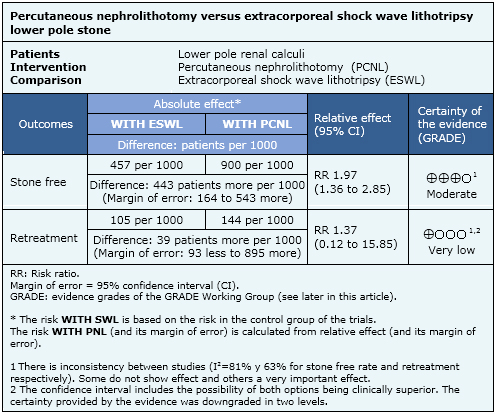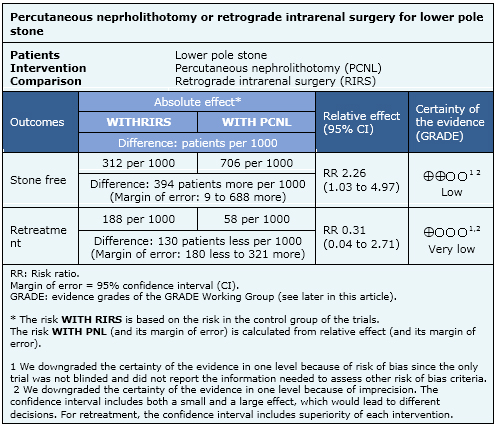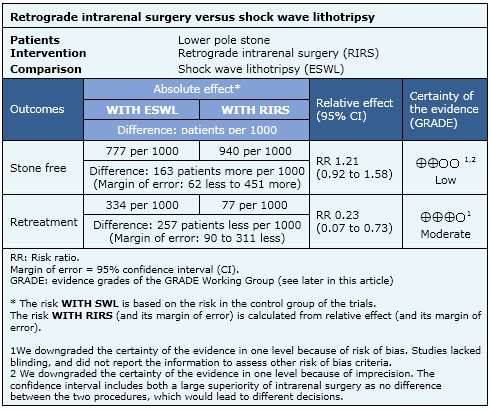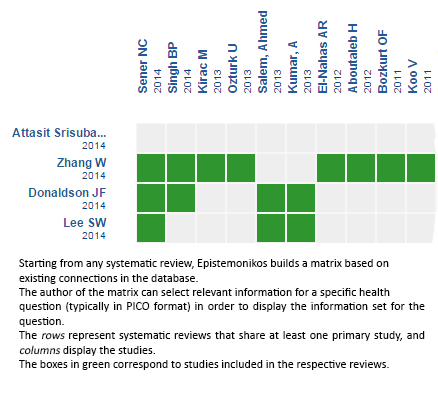Epistemonikos summaries
← vista completaPublished on September 10, 2015 | http://doi.org/10.5867/medwave.2015.6254
Shock wave lithotripsy, retrograde intrarenal surgery or percutaneous nephrolithotomy for lower pole renal stones?
¿Litotricia extracorpórea, nefrolitotomía percutánea o cirugía intrarrenal retrógrada para la nefrolitiasis de polo inferior?
Abstract
Among the therapeutic alternatives available for the treatment of lower pole renal calculi are extracorporeal lithotripsy, percutaneous nephrolithotomy and retrograde intrarenal surgery. There is controversy about which of these techniques is more effective, especially for stones smaller than 20 mm. Searching in Epistemonikos database, which is maintained by screening 30 databases, we identified four systematic reviews including 11 pertinent randomized controlled trials overall. We combined the evidence and generated a summary of findings following the GRADE approach. We concluded percutaneous nephrolithotomy probably increases success rate, but it is not clear if it decreases the need of retreatment compared to extracorporeal shock wave lithotripsy. In comparison to retrograde intrarenal surgery, it may increase success rate, but it is not clear if it decreases the need of retreatment. Retrograde intrarenal surgery may increase success rate, and probably decreases need of retreatment compared to extracorporeal shock wave lithotripsy.
Problem
Nephrolithiasis is a common urological disease in clinical practice. The probability of spontaneously eliminating stones mainly depends on their size and location. Renal lower pole stones have a very low probability of being eliminated so they occasionally require active treatment. Common therapeutic alternatives are extracorporeal lithotripsy, percutaneous nephrolithotomy and retrograde intrarenal surgery. There is controversy about which of these techniques is more effective, especially for stones smaller than 20 millimeters.
Methods
We used Epistemonikos database, which is maintained by screening more than 30 databases, to identify systematic reviews and their included primary studies. With this information we generated a structured summary using a pre-established format, which includes key messages, a summary of the body of evidence (presented as an evidence matrix in Epistemonikos), meta-analysis of the total of studies, a summary of findings table following the GRADE approach and a table of other considerations for decision-making.
|
Key messages
|
About the body of evidence for this question
|
What is the evidence. |
We found four systematic reviews [1],[2],[3],[4], that identified 19 pertinent primary studies reported in 25 references [5],[6],[7],[8],[9],[10],[11],[12],[13],[14], |
|
What types of patients were included |
All studies included patients with renal lower pole nephrolithiasis were included. The studies had a similar proportion of men and women, and they had a wide distribution in terms of age. All studies included patients over 18 years. Pretreatment average diameter of stones ranged between 4 mm and 30 mm. |
|
What types of interventions were included |
Four studies compared percutaneous nephrolithotomy to lithotripsy [6],[8],[23],[27],[28], five compared extracorporeal lithotripsy to retrograde intrarenal surgery |
|
What types of outcomes |
Success of the intervention (defined as being stone free at different periods of follow-up), retreatment rate. Other outcomes were operative time, hospital stay, complication rate (defined as hematuria, fever, sepsis, ileus, etcetera) and quality of life. Length of follow-up ranged from 1 month to 16 months in the different studies. |
Summary of findings
The information on the comparative effects of the different interventions for lower pole renal calculi is based on 11 studies including 885 patients.
1.- Percutaneous Nephrolithotomy versus shock wave lithotripsy
Four randomised controlled trials reported this comparison [6],[8],[23],[27],[28], including 340 patients overall. All studies reported success rate (stone free) at three months and only two studies reported need of retreatment.
- Percutaneous nephrolithotomy probably increases success rate compared to extracorporeal shock wave lithotripsy. The certainty of the evidence is moderate.
- It is not clear whether percutaneous nephrolithotomy decreases the need of retreatment because the certainty of the evidence is very low.

2.- Retrograde intrarenal surgery versus percutaneous nephrolithotomy
Only one randomized trial evaluated this comparison [18], including 33 patients. Stone free rate and retreatment rate were reported at 3 months.
- Percutaneous nephrolithotomy might increase success rate compared to retrograde intrarenal surgery. The certainty of the evidence is low.
- It is unclear whether percutaneous nephrolithotomy decreases retreatment need compared to retrograde intrarenal surgery because the certainty of the evidence is very low.

3.- Retrograde intrarenal surgery versus shock wave lithotripsy
Five randomized controlled trials evaluated this comparison [15],[16],[17],[21],[22],[24],[25],[26], including 508 patients overall. All studies reported stone-free rate and retreatment need at three months.
- Retrograde intrarenal surgery might increase stone free rate compared to extracorporeal lithotripsy, but the certainty of the evidence is low.
- Retrograde intrarenal surgery probably reduces need for retreatment compared with extracorporeal lithotripsy. The certainty of the evidence is moderate.


Other considerations for decision-making
|
To whom this evidence does and does not apply |
|
| About the outcomes included in this summary |
|
| Balance between benefits and risks, and certainty of the evidence |
|
| Resource considerations |
|
|
Differences between this summary and other sources |
|
| Could this evidence change in the future? |
|
How we conducted this summary
Using automated and collaborative means, we compiled all the relevant evidence for the question of interest and we present it as a matrix of evidence.
 Full size
Full size Follow the link to access the interactive version: Extracorporeal shock wave lithotripsy, percutaneous nephrolithotomy or retrograde intrarenal surgery for lower pole renal stones
Notes
The upper portion of the matrix of evidence will display a warning of “new evidence” if new systematic reviews are published after the publication of this summary. Even though the project considers the periodical update of these summaries, users are invited to comment in Medwave or to contact the authors through email if they find new evidence and the summary should be updated earlier. After creating an account in Epistemonikos, users will be able to save the matrixes and to receive automated notifications any time new evidence potentially relevant for the question appears.
The details about the methods used to produce these summaries are described here http://dx.doi.org/10.5867/medwave.2014.06.5997.
Epistemonikos foundation is a non-for-profit organization aiming to bring information closer to health decision-makers with technology. Its main development is Epistemonikos database (www.epistemonikos.org).
These summaries follow a rigorous process of internal peer review.
Conflicts of interest
The authors do not have relevant interests to declare.

